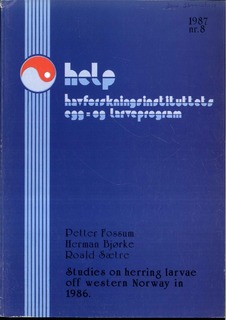Studies on herring larvae off western Norway in 1986
Research report
Permanent lenke
http://hdl.handle.net/11250/115269Utgivelsesdato
1987Metadata
Vis full innførselSammendrag
This report gives some preliminary results from a study on the spawning grounds of the Norwegian spring-spawning herring in April 1986. It deals with the horizontal and vertical distribution of
herring larvae in relation to the physical environment as well as growth and diet.
The spawning area can clearly be seen in the distribution of larvae < 9 mm and these were the same as in 1985. In addition, a smaller
spawning area offshore at the continental slope was identified.
The main features of the circulation pattern of the area seems to be
the same as in 1985. The combined use of hydrography, larvae distribution and Argos drifters seem able to reveal both the larval drift as well as retention areas with a residence time of 10-15 days,
The larval population in 1986 was totally dominated by yolksac larvae.
The number of larvae > 12 mm was about 10% of that found during the same period in 1985. In 1986 a slower growth and a lower feeding
ratio in all larval stages was observed compared to 1985, This indicate poorer recruitment in 1986 than in 1985.
The majority of the larvae were found deeper than 60 m opposed to 1985. The percentage of newly hatched larvae increased with depth.
Older larvae were found mainly in the upper 40 m. Patchy distribution
made a comparison between larvae caught a t day and at night difficult.
First feeding was observed in 3-6 days old larvae. The diet of the larvae was dominated by copepods nauplii. A shrinkage of 40-50% in
dryweight and 3-7% in length due to preservation was observed.
Utgiver
HavforskningsinstituttetSerie
help1987 nr.8
